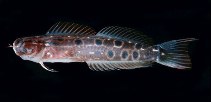| Family: |
Blenniidae (Combtooth blennies), subfamily: Salariinae |
| Max. size: |
4.8 cm SL (male/unsexed) |
| Environment: |
demersal; marine; depth range 0 - 15 m |
| Distribution: |
Western Pacific: known only from Fiji. |
| Diagnosis: |
Dorsal spines (total): 12-12; Dorsal soft rays (total): 13-15; Anal spines: 2-2; Anal soft rays: 16-17; Vertebrae: 32-34. Dorsal fin XII.13-15 (usually 14), deeply notched between spinous and segmented-ray portions. Anal fin II,16 or 17. Pectoral fin 12-14 (usually 13). Segmented caudal-fin rays 13 or 14 (rarely 14). Vertebrae 10 + 22-24 (usually 23). Dentary incisor teeth 47-58 which includes anterior canine teeth very similar in appearance with incisors; posterior canines 1 on each side. Lateral line lacking vertical pairs of pores, terminating posteriorly at point between vertical from interspace between dorsal-fin spines 10 and 11 and vertical from spine 12 (rarely anterior to spine 11). With cirrus on posterior rim of anterior nostril; none on anterior rim. Dorsal row of dark spots below segmented-ray portion of dorsal fin usually not saddle-like; space between pair of dorsal dark body spots just posterior to vertical from anteriormost (of 3) dark spot of ventral row about equal to space between second spot of pair and next spot posteriorly; no pale stripe extending most of midbody length; dark spots on posterior half of body surrounded by conspicuous, discrete, pale rings (Ref. 5296). |
| Biology: |
Oviparous. Eggs are demersal and adhesive (Ref. 205), and are attached to the substrate via a filamentous, adhesive pad or pedestal (Ref. 94114). Larvae are planktonic, often found in shallow, coastal waters (Ref. 94114). |
| IUCN Red List Status: |
Least Concern (LC); Date assessed: 25 March 2009 Ref. (130435)
|
| Threat to humans: |
harmless |
Source and more info: www.fishbase.org. For personal, classroom, and other internal use only. Not for publication.

